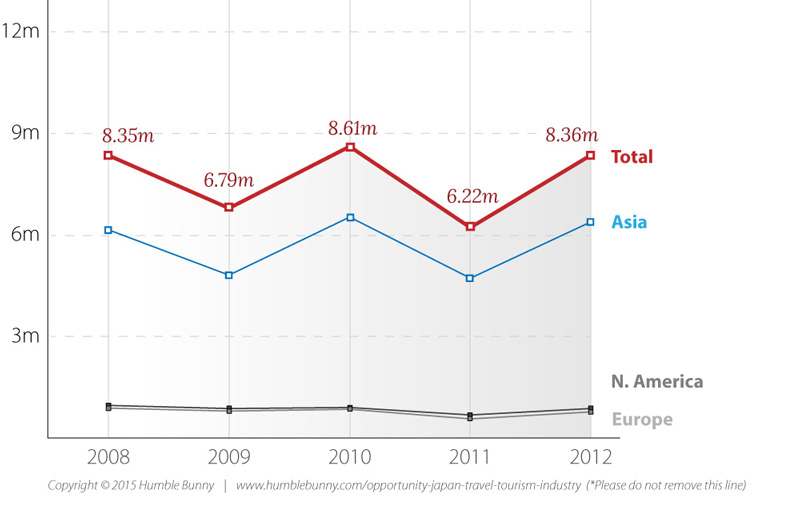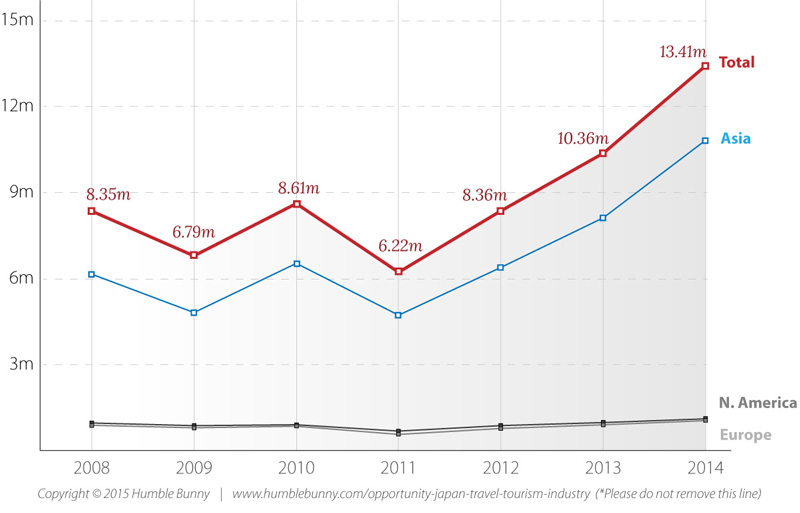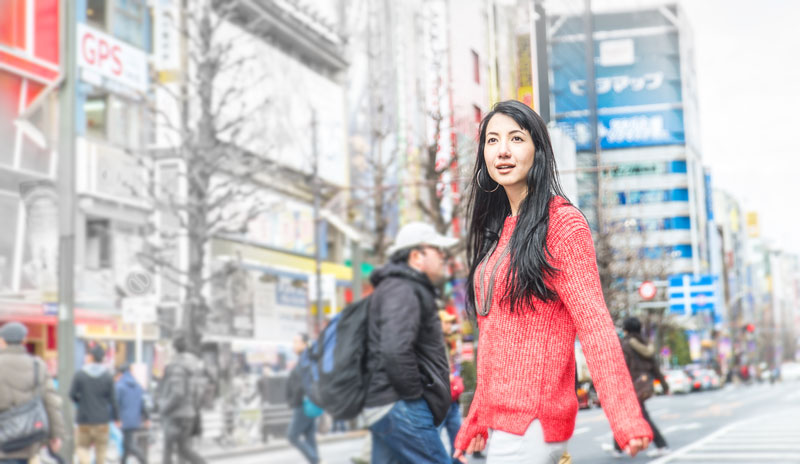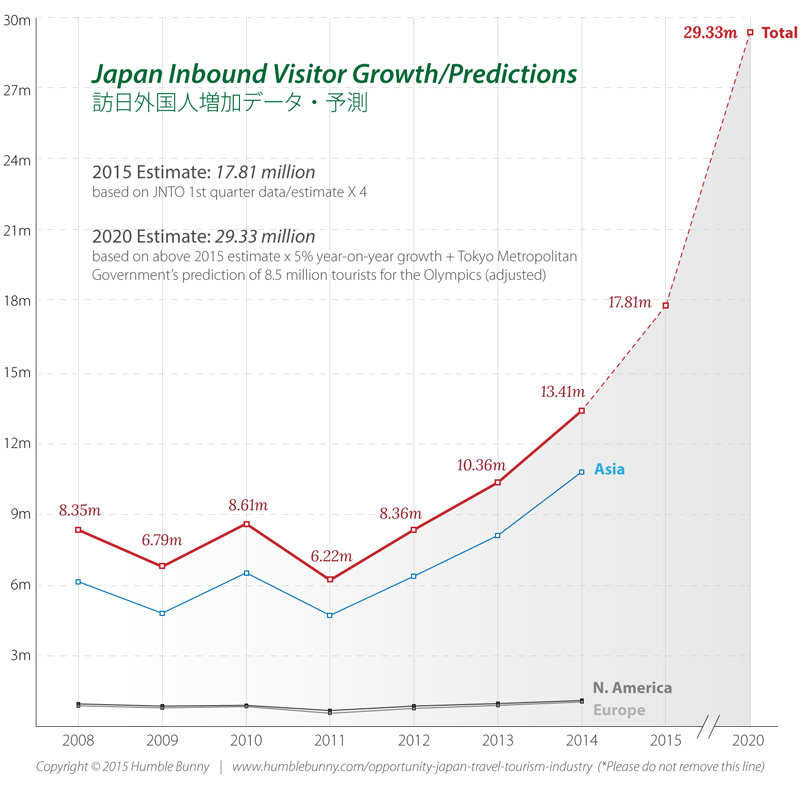Japan’s tourism and travel related companies are currently in an advantageous position for unprecedented growth and expansion. Un-ignorable regional economic factors; local fiscal policies; and future large-scale, international events (yes, plural) have put Japan’s travel and tourism industry (and those companies willing to heed the opportunity) in a pivotal position for success.
In a nutshell, it’s really now or never to kickstart, supplement, and optimize your marketing efforts if you’re operating any sort of tourism-affected business in Japan: from hotels to airline companies, ryokans to restaurants, OTAs to brick and mortar travel agents.
First some background:
The Decline of Inbound Tourism in Japan (2008~2012)

As is common in many industries, Japan’s tourism industry has truly been at the mercy of world economic and other uncontrollable events. Taking a look at the Japan National Tourism Organization’s (JNTO) statistics, we can see two massive catalysts for a crash in tourism here in Japan:
Fall 2008: The Lehman Shock
Initial onset of the Lehman bankruptcy shock saw a drop in about 15-20% of inbound traffic to Japan. Reaching as high as a 50.7% year on year drop in February of 2009. This was not just an economic, money in the bank issue, but the inflation surge thereafter of the Japanese yen made travel a bit more expensive and inaccessible for a lot of individuals.
2009 was a poor year for tourism here in the land of the rising sun. However, much to our surprise and despite the burgeoning strength of the Japanese Yen, 2010 started to see an increase in visitors.
Then there was an earthquake.
Spring 2011: The Great East Japan Earthquake
Where were you? That’s the question everyone asks when disasters strike. It happened with Kennedy, the Challenger, 9/11, and here in Japan, on March 11, 2011. I was gripping the door frames of my old employer as the walls swayed around us for 2.5 endless minutes—and it’s not something those of us here will easily forget.
Nor will the tourism industry which received a huge blow.
Over the 3 months following the quake, inbound traffic to Japan dropped from a then-robust 500,000+ tourists in February to 190,730 (in March), 108,820 (in April), and 183,799 (in May)—nearly one-third of what estimates claimed should have been strong increases.
2011 as a whole gave us an overall 36.2% drop in the number of tourists relative to what we had in 2010.
Thanks a lot radiation woes.
Tourism and Travel Surges Forward

After some recovery in 2012, 2013 brought the beginning of a massive increase of tourism and travel to Japan that continues to this day. Here are the catalysts for that:
Abenomics
Prime Minister Shinzo Abe, came in at the end of 2012 with a big plan to kickstart the economic situation here in Japan through some bold financial policy changes. Through a series of pre-established initiatives entitled “The Three Arrows”, the high value of the yen came plummeting down and travel viability for overseas consumers improved drastically.
In fact, it went too well.
Obviously, the government was aiming for a breakeven point: not inflation, nor deflation. However, the yen kept falling. As of today, we’re looking at a trade of around 120 Japanese yen to one US dollar. This means, Japan went from excessively expensive down to normal, and then even further to what some would consider cheap. In fact, the last time we saw these numbers was back in the fall of 2007, nearly eight years ago.
With the radiation scares slowing down a bit and the realistic understanding that most travel spots are quite disconnected from the Fukushima incident; the inbound tourism industry was ready for a comeback.
But there was another positive factor…
Huge economic growth in the Asian Pacific Region
In 2014, Asian travel into Japan blew both its nearest competitors of Europe and America out of the water by nearly 11 to 1 respectively. Obviously physical proximity is a major part of this, but other things to consider are the economic growth and growing “wealth” (can we use that word yet?) of surrounding nations.
Many of Asia’s economies are booming in growth. Countries like China, the Philippines, Thailand, Taiwan, and Vietnam have seen enough GDP growth that those individuals are not only more financially capable of exploring the world through improvements in salary and local infrastructure, they’re also in a killer position to take advantage of the low domestic costs of actually being in Japan.
Add to that lighter Visa restrictions here in Japan, and some trade/import deregulation (which means better access to brands and products) and you have a country with a lot of appeal to citizens of nearby countries with more limited purchasing power.
GDP growth in 2014:
Myanmar: 8.5%
China: 7.4%
Philippines: 6.2%
Malaysia: 5.9%
Vietnam: 5.5%
Indonesia: 5.2%
When we supplement this with the already strong tourism activity from countries like Hong Kong, Singapore, Thailand, and Taiwan you’re looking at a HUGE chunk of the region actively venturing to Japan for both leisure and business.
Taking that a step further, add in the viability of coming here via Abe’s economic stimulus and you’re seeing a ripe opportunity for asian consumers to not just retain their current rate of travel, but to drastically increase.
Even if the yen were to bolster back to “normal” levels in the near future, these huge boosts in area economies will surely ensure that all of Asia remain a dynamic travel group for the Japanese market for years to come.
Japanese Tourism Now in Data

In 2013, the influx of foreigners into Japan was at a solid 24.0% boost relative to 2012.
In 2014, that jumped by another 29.4% to hit nearly 13.4 million travelers (13,413,467 to be exact) after floating around the 1.2 million number of visitors each month for the second half of the year.
Now it’s 2015. What sort of results are we seeing now?
Here’s what we found:
Taking influence from 2014 figures, a stagnant (yet still respectable) monthly number would have first quarter (January to March) inbound foreigners at around 3.7 million. However, as of writing this article, the number of January and February visitors are currently tallied up at just over 2.6 million.
Based on the JNTO’s predictions for March (which haven’t been published as of writing this), we could expect a total of 1.53 million for March—a quarterly total of somewhere around 4.1 million visitors. That’s a staggering 43.7% first quarter growth upon 2014 which was already doing quite well.
The Future of Japanese Tourism

Feel free to share the above image. download
2015
Due to the influx of economic and other activity in recent years (that we discussed above), we couldn’t find, nor filter out, a conclusive trend in quarterly tourism numbers (dependent on season for example). However, with the above numbers, assuming (a very conservative) 5% quarterly growth (or approximately 200,000 more tourists from quarter to quarter), we’re predicting a minimum of 17.81 million inbound foreigners for 2015.
Let me remind you, that’s against just under 11 million total in 2014.
Let me also remind you that we deliberately estimated these at excessively conservative ratios so it wouldn’t be surprising if these numbers were actually low.
However, to opportunistically evaluate the long-term situation from a forward-thinking business perspective, one MUST pay attention to future potential.
2019 Rugby World Cup
A past client and friend of ours here in Japan, Keith Davies, is a professional coach with over 30 years experience at all levels of the game in Wales, Australia, Japan and England, including winning the 2011 Super-15 with the Queensland Reds. When we asked him about the tourism impact based on his unique positioning in the sport, he ventured that there may be a decent showing of both “west”-based Rugby fans as well as the potential for Asia-based expats to come into Japan. He also mentioned that the location here in Japan is a good middle ground for the powerhouse teams of the northern and southern hemisphere respectively, to come together and battle it out, albeit he worries about hotel room sizes and amenities matching the expectations of this western boom.
Keith is currently coaching one of Japan’s top university teams at Kansai University and has a variety of business interests including The Sticker Family Japan.
2020 Summer Olympics & Paralympics
Even more significant in terms of overall tourism impact, the Olympics are coming to Japan, and we’re pretty excited about that.
Already, the Tokyo Metropolitan Government has estimated 8.5 million tourists to visit for the Olympics alone meaning all those booming asian companies who couldn’t “afford” the Beijing Olympics may now be prepared to fully indulge (they’ve got 5 years to save up anyway).
Combine that with a measly 5% growth from year to year, and then replacing one month’s worth of our 2020 yearly estimate with the government’s estimates, and we wouldn’t be surprised to see a combined influx of about 29.3 million tourists in the year 2020.
How does this all affect my company?

As mentioned above in our estimates, we think it’s pretty obvious how 10.8 million inbound tourists to (most likely more than) 29.3 million tourists in 5 years could affect your company, but let’s spell it out in detail a bit more than that.
First of all, this is opportunity marketing at its absolute finest. A combination of good economic conditions in surrounding countries, an extremely financially accessible Japan (through the deflation of the yen), and multiple upcoming global events mean that your company should be strategically and diligently planning how to take advantage of the forthcoming boom.
Does this have any effect on digital marketing?
Absolutely.
Seeing all this growth we decided to do some quick keyword search data to see if these figures were consistent in an area where we specialize (SEO and inbound marketing). To our expectations, we found a massive influx in English search traffic, especially in 2015:
| keyword | May 2013 | May 2014 | April 2015 |
| “japan travel” | 8100 | 9900 | 14,800 |
| “japanese hotel” | 720 | 880 | 1,300 |
| “sightseeing japan” | 210 | 210 | 260 |
Considering Korea and China make up a good deal (around 60% of inbound tourists), details about Chinese and Korean search were also important.
Naver & Google, which make up about 87% market share of the online search industry in Korea, showed us strong combined results for Japan travel keywords.
Inbound numbers from China have been impressive with an 83.3% rise between 2013 and 2014. When we took a look at the search results, we saw equally impressive numbers.
Obviously these trends in digital match what we’ve discovered in hard travel data.
Your Company’s Next Step
It should be clear now. If your company has the potential to receive any sort of impact from the inbound tourism industry here in Japan, it’s a monumentally opportunistic and essential time for you to begin laying the groundwork and building interest in your brand. The growth possibilities here are astounding—I’d even go so far as to say that this is going to be the turning point for a lot of pre-existing and new companies interested in securing a key position in the industry here.
Multi-lingual implementation and foreign-audience oriented design/layout would be two things to strongly consider. Obviously, a huge number of these individuals will be mobile users as well so a mobile site is key. For companies who have already well-established these things: A/B testing and performance-based improvements will help optimize your efforts before the influx. Beyond that, a consistent marketing plan geared specifically towards those individuals and designed to draw traffic to your website or other key sales funnels will be a necessity.
Who are we to talk about this?
Humble Bunny is a web design and digital marketing company as it pertains to Japan and the Japanese market. In February, we helped launch a brand new bilingual corporate website for one of Japan’s top travel companies: the Venture Republic Group, gaining valuable insight from their team during the process. We’re also in the planning stages for a media-based travel sight based in Japan, and have partnered with another firm to develop, market, and launch a white label Hotel marketing app.
If you’re interested in leveraging our experience, please fill out our three-line inquiry form on our contact page to tap our brains for more insight and ideas. For companies that are truly serious about moving forward, we can also provide you a more formal ‘NPSP’ introduction to how we’ve helped companies like yours, and build a preliminary plan based on your business and its goals.
Article Sources:
JNTO
MLIT
Tourism.jp
The Japan Times
XE